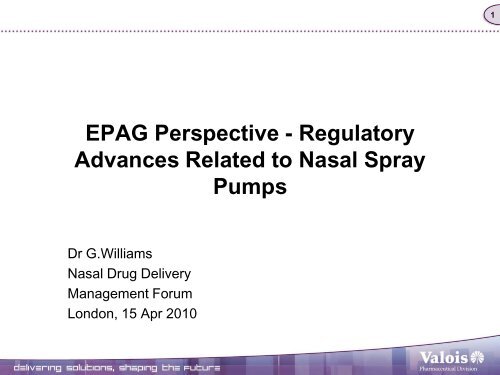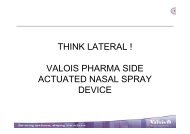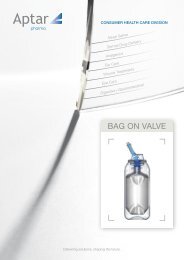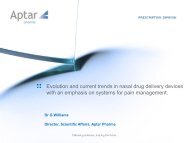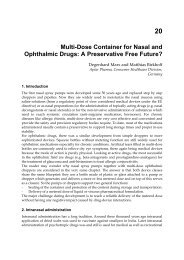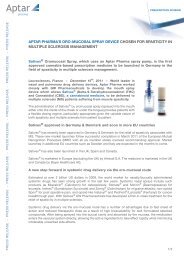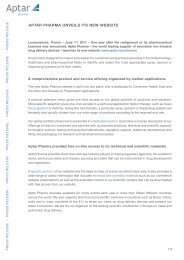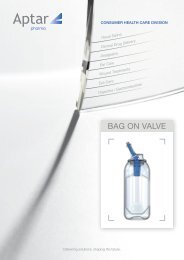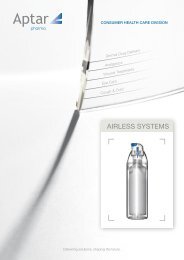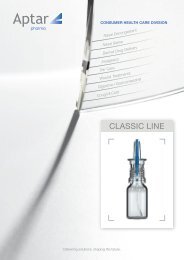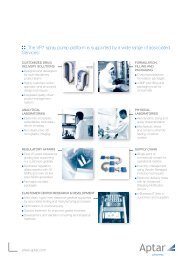Create successful ePaper yourself
Turn your PDF publications into a flip-book with our unique Google optimized e-Paper software.
1EPAG Perspective - RegulatoryAdvances Related to Nasal SprayPumpsDr G.WilliamsNasal Drug DeliveryManagement ForumLondon, 15 Apr 2010
Overview2• EPAG, what is it?, background, this project…• Regulatory guidance• Pharmacopeial guidance• What current in-vitro testing methods can and can nottell us• Defining mass fraction penetrating the nasopharynx• Methods applied and results to date for % particles
EPAG, what is it?, background, this project…3• EPAG Organisation (European PharmaceuticalAerosol Group)• Voluntary organisation• Self managed• Annual fee (non-profit making basis), Funding studies, experts etc• Rules & Constitution• EPAG Membership, current Feb 2010• 3M, Almirall Sofotec, AstraZeneca, Bespak Europe Ltd, Boehringer Ingelheim, Chiesi,Clinical Designs Ltd, GlaxoSmithKline, Hovione, Novartis, Pari, Pfizer, sanofi-aventis,Siegfried Pharma Development, SkyePharma, Teva, Trudell Medical International,Valois, Vectura
EPAG, what is it?, background, this project…4• Objectives• Focus on pharmaceutical issues relevant toPulmonary and Nasal Delivery products, includingclinical aspects as appropriate• Establish scientifically based best practices• Provide consensus comment to Industry andGovernment Agencies to promote safety and qualitystandards• Recommend harmonised standards and methodology
EPAG, what is it?, background, this project…5• EPAG Membership• Membership is open to:• European Pharmaceutical Companies that develop new drug product forhuman use utilising the Pulmonary or Nasal route of delivery• Product development takes place in collaboration with other Pharmaceuticalcompanies as well as non-Pharmaceutical companies (e.g. API suppliers,device design and componentry manufacturers, consultants etc). Thesecompanies may be invited to attend when a particular need is identified.• Companies, including non-European companies, may be admitted asmembers where they provide specific expertise that supports and enhancesEPAG objectives
EPAG, what is it?, background, this project…6• This project…,• European pharmacopeia methodology for Nasal sprays• Aerodynamic particle size analysis of two fractions. (< 10µm >)• Methodology produces data as representative as possible of the sprayexiting the device orifice• Method validation package
REGULATORY: Heath Canada-EMEA7• Heath Canada-EMEA:– Joint Guideline on the Pharmaceutical Quality ofInhalation and Nasal Products– EMEA/CHMP/QWP/49313/2005 Corr - Section 4.2.2• The tests indicated in Table 4.2.2 are normallyconducted to characterize nasal products– Not all tests are necessary for all types of nasal products(see guideline for details)
REGULATORY: Heath Canada-EMEA8• Covers 6 distinct categories of nasal delivery devicePressurizedmetered dosenasal spraysNasal powders(devicemetered)Nasal liquidsSingle usedropsMultiple usedropsSingle usespraysNonpressurizedmultiple usemetered dosesprays
REGULATORY: Heath Canada-EMEA9Pharmaceutical development studiesPhysical characterizationMinimum fill justificationExtractables/leachablesDelivered dose uniformity through container lifeParticle/droplet size distributionActuator depositionShaking requirementsInitial & re-priming requirementsCleaning requirementsLow temperature performancePerformance after temperature cyclingEffect of environmental moisturerobustnessDelivery device development
US Regulatory requirements10• USFDA (CDER):• July 2002: Guidance for Industry - Nasal Sprayand Inhalation Solution, Suspension, and SprayDrug Products — CMC Documentation• April 2003: Draft Guidance for Industry -Bioavailability and Bioequivalence Studies forNasal Aerosols and Nasal Sprays for Local Action
CMC documentation: Nasal sprays11Description Identification AssayImpurities andDegradation ProductsSpray ContentUniformityPreservatives and PumpDeliveryStabilizing ExcipientsAssaySpray Pattern andPlume GeometryPump DeliveryDroplet SizeDistributionParticle Size Distribution(Suspensions)Particulate MatterMicrobial LimitsNet Content Weight Loss (Stability) Leachables (Stability)pH Osmolality Viscosity
Inhalation solutions, suspensions and sprays12Description Identification AssayImpurities andDegradation ProductsPreservatives and stabilizingExcipientsAssaySterilityParticulate matter pH OsmolalityNet content Weight Loss (Stability) Leachables (Stability)Particle size distribution(suspensions)Pump delivery for inhalationspraysSpray content uniformity forinhalationspraysPlum geometry for inhalationspraysParticle/droplet sizedistribution for inhalationsprays-
Draft Nasal BA/BE guidance …13Single Actuation Content ThroughContainer LifeDrug in Small Particles/Droplets,or Particle/Droplet SizeDistribution by Cascade ImpactorSpray patternDroplet Size Distribution by LaserDiffractionDrug Particle Size Distribution byMicroscopyPlume geometryPriming and re-priming -
Pharmacopeial guidance14• Ph. Eur.• 6th Edition (2010):• Nasal Preparations‘Nasalia’:• Tests for uniformity ofdosage units, mass,content for nasaldrops/liquid nasal sprays• Monograph undergoingrevision to includedroplet/particle sizingmethodologies as well asmore detail on meandelivered dose and doseuniformity• Inhalanda Committee• USP:• • USP 32/NF 27 (2009):• Nasal Sprays are includedas one of the oral and nasalinhaled drug products(OINDPs) under „Physical Tests &Determinations‟• Tests for delivered dose uniformity• N.B. includesmethods for particle sizingdeveloped for oral ratherthan nasal inhaledpreparations
What current in-vitro methods can and can nottell us15CAN PROVIDE MEASURES OF:• Dose content• Dose content uniformity throughlife• Entire droplet and particle sizedistribution• not traceable to drugsubstance by currently acceptedmethod of laser diffractometry• Spray pattern and geometryLIMITATIONS:• No standardized entry portmimicking nares and nasalvestibule• Necessary if mass fractionsare required• Mass fraction < ca. 10 μmaerodynamic diameter likely topenetrate beyond the nasopharynx• New Test Needed
Defining the mass fraction penetrating thenasopharynx16• 1st STEP:• Define standardizedentry port:• Doub and Adams (2002 – AAPSAnnual Meeting) exploredvarious sizes of inverted roundbottomed flasks for use testingnasal spray pumps• Linked with abbreviated cascadeimpactor to determine massfraction
Define standard entry port17• Doub and Adams (2002):• 1 L flask was too small• Larger (2 L and 5 L flasks)required a pre-separator• • Observations-1:• Choice of a fixed flow rate waslimiting:• Adult: 10-40 L/min• Häußermann et al. J.Aerosol Sci.(2002);33:929-933.• Adult: 7 – 50 L/min• Child: 5 – 20 L/min• Cheng AS&T. (2003); 37:659-671Observations-2:• Even a 2 L flask is much largerthan the ca. 15 mL volume of thenasal cavitycourtesy J.D. Suman, Nextbreath LLC
Define standard entry port18• JM Aiache (2002):• Glass nasal induction port• For use with twin impinger• Observations:• Recoveries between 98-107%• Used at 30 & 60lpm• Used commercially for anumber of yearscourtesy J.M.Aiache
Nasal induction port design19Work is in progress withinthe Nasal Delivery Sub-Team of the EuropeanPharmaceutical AerosolGroup (EPAG) to developan induction port thatmore closely approximatesin internal volume andorientation presented tothe inhaler as would be thecase when used by apatientPossible nasal induction port configurationscourtesy Copley Scientific Ltd, and 3M DDSD
Defining the mass fraction penetrating thenasopharynx202nd Step: Establish a size-selective cutpointclose to 10 μm aerodynamicdiameter:• Requires inertial classifier following inlet• Impactor pre-separator almost certainlyneeded if a low volume induction portis used• 3rd Step: Optimize choice of inertialimpactor:• A conventional 7 or 8 stage full resolutionsystem could be used• However, abbreviated 1 or 2 stageimpactors are becoming available:• Greatly simplify the measurementprocess• More rapid measurement possible –better coverage/decision making forbatch disposition in QC
Size, characterizing the entire dose21• Inertial impaction methods areineffective for droplets > 20 μmaerodynamic diameter• Mass median droplet sizesfor nasal spray pumps aretypically in the 40-80 μmrange• Laser Diffractometry (LD)has become the industrystandard• Recommended techniquefor nasal sprays and nasalaerosols in the FDA BA/BEDraft GuidanceMalvern SpraytecLD with nasal spraypump and automatedactuatorCourtesy Malvern Instruments
Time averaged v-PSD22• Indicative of overallinhaler performanceduring selected samplingperiod• Less useful than timedependent mode forstudying inhaler operationthrough a completeactuation cycleVolume (%)2010090807060105040302010000.1 1.0 10.0 100.0 1000.0Diametre des Particules (µm.)
Time averaged v-PSD23• Capable of viewing transientphenomena of millisecond duration:• Spray/aerosol formation• Spray/aerosol development duringoperation of inhalerStart up stable phase tail off
Developing technology with API specificity24• LD, though versatile, does notprovide chemical speciesidentification linked to thedroplet PSD:• A problem for multicomponentformulations• …or where non-activeexcipient(s) are present• …or even with singlecomponent, suspension APIs
Raman chemical imaging25• Raman shifts specific to API(s) excipients etc. enablechemical composition of particles imaged to bedisplayed in a quantitative mannerOptical imageAPI identified by colourcourtesy J.D. Suman, Nextbreath LLC
Next steps for API specific imaging26• Extend RCI method to identify additional formulationproducts• Develop automated analytical methods to enable morerepresentative sampling• Develop algorithms fusing brightfield microscopy dataand RCI to improve particle sizing• Compare RCI with standard ingredient-specificmethods used to establish bioequivalency betweenbrand and generic nasal products Raman shiftsspecific to API(s) excipients etc. enable chemicalcomposition of particles imaged to be displayed in aquantitative manner
Challenges….27• Identify suitable nasal induction port• Identify suitable analytical technique andmethods for measuring % particles
Methods applied to date….28Nasal inlet ports + ACI (short)Inverted NGI + “6L” inlet chambercourtesy GSKInverted NGI + pre-separatorcourtesy RIVMLaser light scattering
Results to date….29Inverted NGI& pre-separator (BDP)None < 10 µmInverted NGI& “6L chamber” (BDP)~1-2% < 10 µmNasal induction port & reduced stack ACI (BDP) None < 10µmMalvern SpraytecLaser light scattering (BDP)~ 0.01% < 10µmInverted NGI& pre-separator (Xylomzn)
Next steps….30• Build data base of %
Acknowledgments and thanks to ….31• EPAG nasal sub team• S.Nichols, J.Mitchell (Trudel), C.Blatchford (3M),K.Hawkins (Teva), JM Aiache (Ind), A.Slater (GSK),B.Doub (FDA), B.Wyka, J.Suman (Nextbreath),T.Purewal, J.Schiewe (BI), M.Weida (RIVM, TheNetherlands), G.Williams (Valois, sub-team leader),


